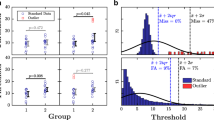Abstract
Cluster statistics of percolation theory have been shown to generate expressions for the distribution of hydraulic conductivity values in accord with field studies. Percolation theory yields directly the smallest possible generalized resistance value, R c, for which a continuous path through an infinite heterogeneous system can avoid all larger resistances. R c, defines an infinite system hydraulic conductivity. Cluster statistics generate the number of clusters of resistors of a given size with a given R, for which a continuous path through the cluster can avoid resistances larger than R. The probability that a volume of size x 3 ‘falls on’ a particular cluster gives the probability that volume has a characteristic resistance, R. Determining the semi-variogram of the hydraulic conductivity is now elementary; it is necessary only to determine whether translation h of the center of the volume x 3 removes it from the cluster in question. If the cluster is larger than (x+h)3, then, on the average, the same cluster resistance R will control K. Otherwise, the value of K at x+h will be uncorrelated with its value at x. The condition is then expressed as an integral related to the one, which gives the distribution of K. Then an integral over the derived distribution of K gives the variogram. Results obtained are that the variogram should be similar to either the exponential or Gaussian forms typically in use, if K is a power law function of random variables (as in Poiseuille’s Law), or more closely related to the spherical approximation if K is an exponential function of random variables.
Similar content being viewed by others
References
Ambegaokar, V., Halperin, B., and Langer, J. S.: 1971, Hopping conductivity in disordered systems, Physical Rev. B 4(8), 2612–2620.
Deutsch, C. V., and Wang, L. B.: 1996, Hierarchical object-based stochastic modeling of fluvial reservoirs, Math. Geo. 28(7), 857–880.
Freeze, R. A.: 1975, A stochastic-conceptual analysis of one-dimensional groundwater flow in nonuniform heterogeneous media, Water Resour. Res. 11, 725–741.
Friedman, L. and Pollak, M.: 1981, The Hall effect in the variable hopping regime, Philosophical Magazine 44(4), 487–507.
Friedman, N. A., and Seaton, S. P.: 1998, Critical path analysis of the relationship between permeability and electircal conductivity of three-dimensional pore networks, Water Resour. Res. 34(7), 1703–1710.
Gomez-Hernandez, J. J. and Wen, X.-H.: 1998, To be or not to be multi-Gaussian – A reflection on stochastic hydrogeology, Adv. Wat. Res. 21(1), 47–61.
Hocksema, D. J. and Kitanidis, P. K.: 1985, Analysis of the spatial structure of properties of selected aquifers, Water Resour. Res. 21, 563–572.
Hunt, A. G.: 1999, Dependence of the hydraulic conductivity on space and time scales, In: R. van Genuchten, F. Leij and L. Wu (eds), 1997 USDA Salinity Lab Workshop on Vadose Zone Hydraulic Properties, Riverside, CA.
Hunt, A. G.: 1998, Upscaling in subsurface transport using cluster statistics of percolation, Transport in Porous Media 30(2), 177–198.
Hunt, A.: 1992, The low frequency conductivity of the Fermi Glass, J. Physics: Condensed Matter 4(33), 6957–6970.
Journel, A. and Huijbregts, Ch. J.: 1978, Mining Geostatistics, Academic, London.
Jury, W. A., Gardner, W. R., and Gardner, W. H., 1991, Soil Physics, 5th edn, Wiley, New York, pp. 286–288.
Kirkpatrick, S.: 1973, Hopping conduction: Experiment versus theory, In: J. Stuke and W. Brenig (eds) 5th Annual Conference on Amorphous and Liquid Semiconductors: Proceedings, Taylor & Francis, London, pp. 103–107.
Kupfersberger, H., Deutsch, C. V. and Journel, A. G.: 1998, Deriving constraints on small-scale variograms due to variograms of large-scale data, Math. Geo. 30(7), 837–852.
Nielsen, D. R.: 1973, Spatial variability of field-measured soil–water properties, Hilgardia 42, 215–259.
Paleologos, E. K., Neuman, S. P. and Tartakovsky, D.: 1996, Effective hydraulic conductivity of bounded, strongly heterogeneous porous media, Water Resour. Res. 32(5), 1333–1341.
Pollak, M.: 1972, A percolation treatment of dc hopping conduction J. Non-Cryst. Solids 10, 1.
Seager, C. H. and Pike, G. E.: 1974, Percolation and conductivity: a computer study. II, Physical Rev. B 10(4), 1435–1446.
Sharma, M. L., Gander, G. A., and Hunt, C. G.: 1980, Spatial variability of infiltration in a watershed, J. Hydrology 45, 101–122.
Stauffer, D.: 1979, Scaling theory of percolation clusters, Physics Reports 54(1), 1–74.
Warrick, A. W., Myers, D. E. and Nielsen, D. R.: 1986, Geostatistical methods applied to soil science, In: A. Kline (ed.), Methods of Soil Analysis: Part 1, Monograph 9, American Society of Agronomy, Madison, WI, pp. 53982.
Author information
Authors and Affiliations
Rights and permissions
About this article
Cite this article
Hunt, A.G. Percolation Cluster Statistics and Conductivity Semi-Variograms. Transport in Porous Media 39, 131–141 (2000). https://doi.org/10.1023/A:1006629013418
Issue Date:
DOI: https://doi.org/10.1023/A:1006629013418




